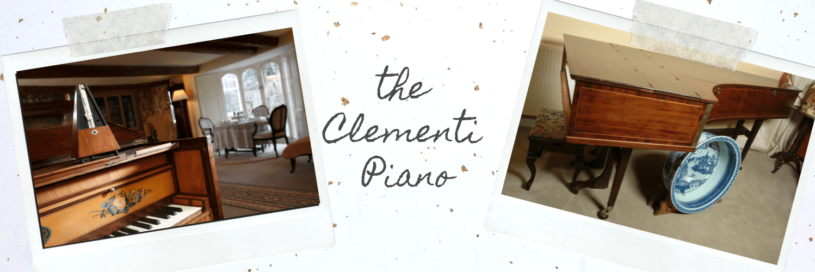The Cossington piano is a Clementi grand believed to date from 1810-1815.
The wonderfully named, and talented, Muzio Filippo Vincenzo Francesco Saverio Clementi (1752 to 1832) was an Italian-born English composer, pianist, pedagogue, conductor, music publisher, editor, and piano manufacturer.
According to Wikipedia, he was sponsored as a young composer by Sir Peter Beckford who took him to England to advance his studies. Later, he toured Europe numerous times from his long-standing base in London. It was on one of these occasions, in 1781, that he engaged in a piano competition with Wolfgang Amadeus Mozart.
Influenced by Domenico Scarlatti’s harpsichord school and Haydn’s classical school and by the stile galante of Johann Christian Bach and Ignazio Cirri, Clementi developed a fluent and technical legato style, which he passed on to a generation of pianists, including John Field, Johann Baptist Cramer, Ignaz Moscheles, Giacomo Meyerbeer, Friedrich Kalkbrenner, Johann Nepomuk Hummel and Carl Czerny. He was an important influence on Ludwig van Beethoven and Frederic Chopin.
Clementi was a notable music publisher. In 1798, he took over the firm Longman and Broderip at 26 Cheapside (then the most prestigious shopping street in London), initially with James Longman, who left in 1801, and from 1806 Clementi also had offices at 195 Tottenham Court Road. Because of this activity, many compositions by Clementi’s contemporaries and earlier artists have stayed in the repertoire.
In 1807, Clementi struck a deal with one of his greatest admirers, Ludwig van Beethoven, which gave him full publishing rights to all of Beethoven’s music in England. He edited and interpreted Beethoven’s music but has received criticism for editorial work such as making harmonic ‘corrections’ to some of Beethoven’s scores. That Beethoven, in his later life, started to compose chamber music specifically for the British market may relate to the fact that his publisher lived in London.
Clementi also began manufacturing pianos, but on 20 March 1807, a fire destroyed the warehouses occupied by his new firm in (well named!) Rotten Road. Nevertheless, in 1810Clementi stopped performing in order to devote his time to composition and to piano making. On 24 January 1813, together with a group of prominent professional musicians in England, he founded the ‘Philharmonic Society of London’, which became the Royal Philharmonic Society in 1912.
Clementi’s piano business flourished, affording him an increasingly elegant lifestyle. As an inventor and skilled mechanic, he made important improvements in the construction of the piano, some of which have become standard in instruments to this day.
Clementi is buried in Westminster Abbey.
We do not know how the Clementi piano came to Cossington Park. It is an old and fragile instrument that has been repaired on many occasions with greater or lesser skill. It requires tuning and other attention before every use and is there unfortunately unavailable except on special request and payment of the tuning fee.
Nevertheless, the piano has brought joy to many and has been used for concerts at Cossington Park.
